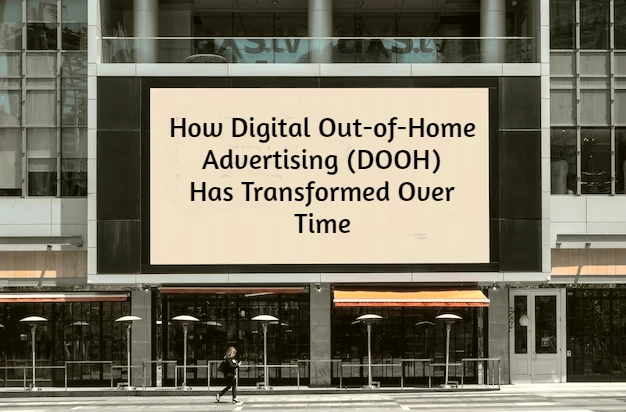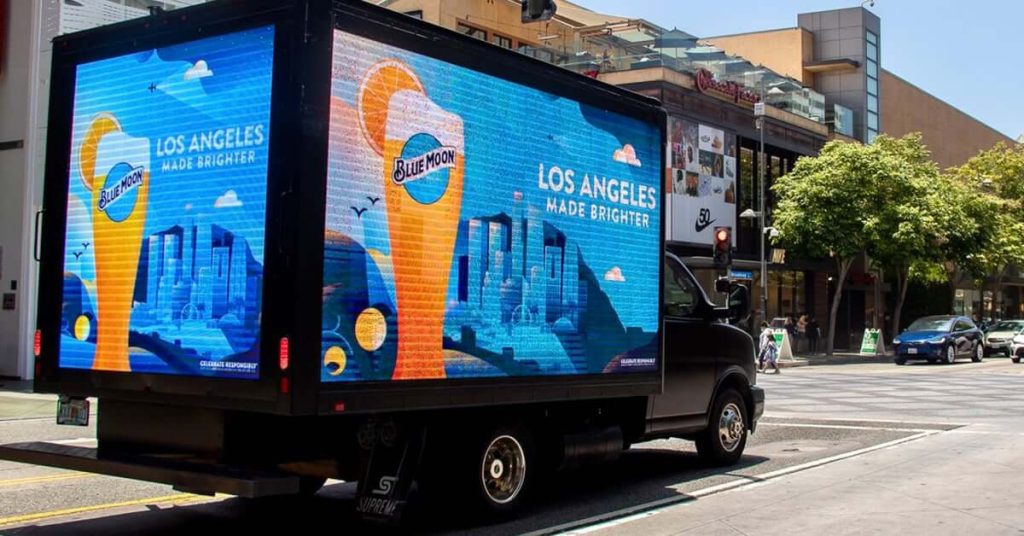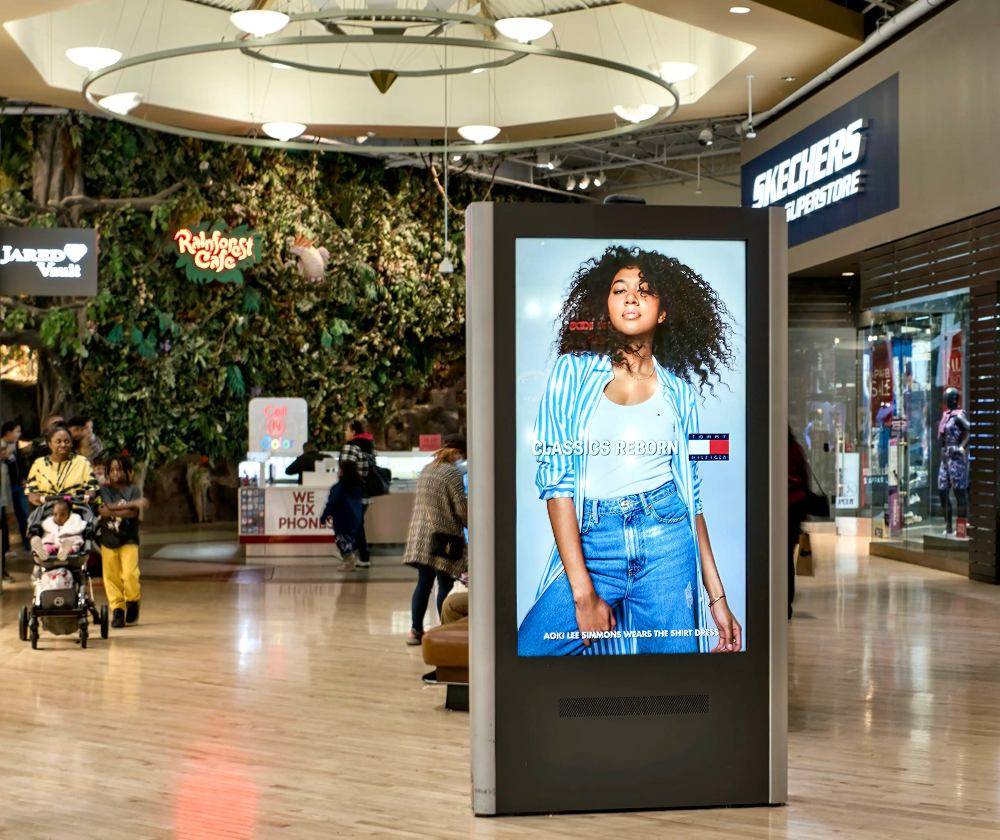Out-of-home (OOH) advertising, including digital out-of-home (DOOH) advertising, refers to promotional messages targeting consumers when they are outside their homes. These messages can appear on billboards, transit vehicles, street furniture, and other public spaces.
I have added a video of out-of-homes advertising dated n 1930 in New York. scroll down to see
History vids
The origins of out-of-home advertising can be traced back to ancient times when merchants used signs and symbols to promote their goods and services. However, the modern concept of out-of-home advertising began to take shape in the late 19th and early 20th centuries with the emergence of billboards and posters.

The specific origins of DOOH advertising are a bit more recent. While the exact date and location of the first digital out-of-home advertisement are difficult to pinpoint, the adoption of digital technology in outdoor advertising started gaining momentum in the late 20th century and early 21st century. This development allowed advertisers to display dynamic and interactive content on digital screens in public spaces, offering greater flexibility and creativity compared to traditional static displays.
DOOH advertising has since evolved rapidly, incorporating advancements in technology such as data analytics, audience targeting, and interactivity. Today, it is a dynamic and innovative form of advertising that continues to grow in popularity and effectiveness, reaching consumers in various locations and contexts outside their homes.
What Is Digital Out-of-Home (DOOH)?
Digital out-of-home (DOOH) advertising refers to the use of electronic display media to showcase a variety of static and moving advertisements. It allows advertisers to reach specific audiences and deliver customized ads to them.
Back in the early 2000s, digital out-of-home (DOOH) advertising started making its mark as digital screens popped up in public spots like malls, train stations, and stadiums. It was a fresh concept, and advertisers were eager to explore how to use these screens to catch people’s attention.
One standout example from those early days was Times Square in New York City, where LED screens displayed all sorts of eye-catching images and animations. This sparked interest worldwide, but there were hurdles to overcome.
One big obstacle was the high costs involved in setting up and maintaining these digital screens, not to mention the hefty internet bills. This made it tough for smaller businesses with tighter budgets to get in on the action. Even today, many small and medium-sized enterprises (SMEs) find it hard to justify the expense of DOOH advertising.
Instead, they often opt for more affordable advertising options rather than splurging on flashy digital ads in major cities like Shanghai, California, or New York. The high costs remain a barrier for many, despite the allure of reaching a large audience with dynamic content.
Interactive DOOH Advertising: The Next Big Thing
As technology advances globally, the rise of interactive digital out-of-home (DOOH) advertising was inevitable. Introducing touch screens and gesture-based technology has revolutionized the evolution of DOOH, offering businesses the opportunity to create more immersive and engaging advertising experiences.
Nowadays, interactive display ads are a common sight on touch screens in various public spaces such as train stations, shopping malls, airports, galleries, and more. These touch screen ads allow users to directly engage with the content, providing a more hands-on experience compared to traditional static ads.
On the other hand, gesture-based technology takes interactivity to the next level. By utilizing cameras and sensors, this technology can detect and respond to human movements, enabling users to interact with advertisements without physically touching the screen. This creates a futuristic and captivating experience that captures the attention of passersby in a whole new way.
Overall, the integration of touch screens and gesture-based technology has significantly enhanced the effectiveness of DOOH advertising, making it more interactive, memorable, and impactful for both businesses and consumers alike.
Interactive DOOH Advertising Examples:
I was able to pick out few done by brands and have shared below
- “Share a Coke” Campaign by Coca-Cola: Customers could personalize their Coca-Cola bottles using touchscreen technology.
- “SmileBooth” Campaign by British Airways: Used facial recognition to take photos of smiling customers, displayed on digital billboards in London.
Advantages:
- Targeting and Retargeting: Understand customer preferences and behaviors.
- Higher Engagement: Interactive ads receive more attention and provide valuable data.
- Competes with Digital Devices: Reach customers outside, away from their phones.
- High Visibility: Dynamic content stands out in crowded spaces.
Challenges:
- Cost: Billboard usage can be expensive.
- Reliability and Privacy Concerns: Ensure ads are easy to understand and respect privacy.
- Glitches: Technical issues can impact effectiveness.
To mitigate challenges, consider careful placement and utilization of programmatic DOOH solutions.
Navigating the Rise of Programmatic Advertising in DOOH
Programmatic digital out-of-home, or pDOOH, is all about buying and selling ad space on digital screens in public places, but with automation. It’s like when you order something online and it’s all done automatically. This way, advertisers can make their ads super personalized by aiming them at specific groups of people based on where they are, what time it is, and even the weather.
Brands like NSE LED are really making waves in this area by creating amazing high-quality LED screens that are perfect for using programmatic digital-out-of-home advertising on a big scale.

Some of the cool things about pDOOH include:
- Using Smart Data: With pDOOH, you can figure out where a certain group of people usually go. This helps you understand how people move around and lets you adjust your ads to fit that audience better.
- Artificial Intelligence (AI): AI is changing everything, and pDOOH software is using it to show ads based on things like the time of day, the weather, and who’s walking by the screen. The goal is to only show ads that matter to the people watching.
- Reaching Your Target Audience Right Away: Unlike regular out-of-home ads, which focus on where you put them, pDOOH looks at who’s watching. To do this well, you have to set really specific rules for the system to use, so it can find the right audience super accurately and quickly.
The DOOH industry has had a tough time with online ads, but this shift to audience-based ads is a big deal for the field. Using data to aim at specific groups of people in real-time makes DOOH advertising more useful and powerful. So, if you want to step up your marketing game, mixing programmatic advertising with regular digital out-of-home is the way to go.
Different Ways Programmatic Out-of-Home Advertising Works
Types of Programmatic Out-of-Home Advertising
- Digital Billboards: These are modern versions of traditional billboards, using LED technology to stand out, especially at night. They’re eye-catching and effective for grabbing attention and driving conversions.
- Digital Screen Media: This includes screens in places like stadiums, airports, malls, and offices. They’re versatile for branding, advertising, and providing information. Their dynamic content engages various audiences and adds depth to messaging.
- Transit Advertising: Ads on public transportation and stations, like buses, taxis, and train stations. They reach commuters in busy locations, offering high visibility and constant exposure.
- Place-based Advertising: Ads placed in specific locations to target particular groups. They often use digital content to interact with audiences who frequent those areas.
- Ads on Public Furniture: Ads on street furniture like bus shelters and phone booths. They attract attention in high-traffic areas and encourage immediate action.
- Point of Sale Advertising: Ads at checkout counters and cash registers. They prompt impulse purchases and promote complementary products to customers already making a purchase.
Crafting an Effective Digital Out-of-Home Advertising Strategy
Choosing the optimal digital out-of-home strategy for your brand hinges on various factors such as your target audience, budget, and campaign objectives. However, regardless of your specific circumstances, here are some tried-and-tested generic digital out-of-home advertising strategies:
- Get Creative: Being creative is crucial in DOOH ads. Many brands have attracted new customers simply by being creative with their ads. To stand out, think outside the box and create visually appealing content with vibrant colors and clear messaging that grabs attention right away.
- Target the Right Locations: Place DOOH ads strategically to maximize audience reach. Tailor ads to specific locations for optimal impact, especially if your audience is concentrated in certain areas.
- Create Interactive Ads: Enhance effectiveness with interactive content. Engage consumers by allowing direct participation, fostering a memorable brand experience. Harness programmatic technology to enable interactivity in DOOH advertising.
- Utilize Real-Time Data Triggers: Make your ads more relevant and timely by leveraging real-time data such as weather or traffic conditions. Dynamic content based on weather can set your brand apart, offering sponsored weather updates or tailored content.
For instance, as a coffee shop owner with digital signage near the entrance, use weather triggers to display contextually relevant ads. Show hot drinks when it’s cold (around 18°C) and switch to cold drinks when it’s warmer (above 20°C). This approach saves time, grabs attention, and promotes desired products effectively.
Leverage Weather Data Triggers: Enhance community engagement by displaying weather forecasts every 5-10 minutes. Adding value to your local area is key to effective advertising.
Embrace Programmatic Advertising: Utilize programmatic tools for precise targeting and optimization of DOOH campaigns. Harness data and algorithms to enhance effectiveness.
Enhance Storytelling with Multiple Screens: Engage viewers more effectively by using video content with multiple slides to tell a story. This approach is more engaging than a single static image and captures attention better.
Read also: How to handle a Promotion to Another City
Examples of the Digital Out of Home
In today’s digital out-of-home advertising landscape, advertisers have plenty of choices. Here are some popular options:
1. Digital Transit Advertising
This includes ads you see on public transport like buses and taxis, as well as signs in transit stations.

2. Digital Mall Advertising:
This is when ads are shown inside and outside malls using screens. It’s a modern way to get brands noticed more.

This is a great way to advertise products in malls because lots of people visit malls to shop and have fun. Nowadays, digital mall advertising is a really effective way to reach specific groups of people and get brands noticed more.
Read also: 8 Simple Ways to remove Privacy Protection Password (Anti-theft)
3. Digital Cinema Advertising:
This is when ads with sound, color, and motion are shown on digital screens in cinemas. It can be anything from slides to actual movie clips.

The Advantages of Digital Out-of-Home Advertising
Digital out-of-home (DOOH) advertising offers many advantages for both advertisers and consumers:
- Wide Reach: DOOH ads reach a large audience and quickly grab attention with their attractive displays.
- Flexibility: Unlike traditional ads, which are time-consuming to change, DOOH ads can be updated instantly and display multiple messages on one screen. This flexibility allows advertisers to promote different products or target different audiences easily.
- Respectful Audience Targeting: DOOH ads use environmental factors, such as location and demographics, to target specific audiences without invading privacy. This makes them a respectful and effective form of advertising.
- Storytelling: DOOH ads can tell stories and take viewers on a journey, making them more engaging and memorable than static ads.
- Increased Engagement: DOOH ads can be interactive, allowing consumers to engage with them using their smartphones. This engagement can lead to valuable interactions, such as entering contests or receiving discounts, enhancing customer satisfaction and brand loyalty.
- Cost-Effectiveness: DOOH advertising can be more affordable than traditional methods, especially for small businesses. Advertisers can share space with other brands or pay for continuous ads on digital screens.
Read also: How to Block or Deactivate Bank USSD Code in Nigeria (2024)
How DOOH Ads Are Merging with Social Media and Mobile Marketing
As a business, you’re always on the lookout for fresh ways to get your products and services out to more people. What if you could blend your traditional marketing with something that reaches the right audience?
Combining digital out-of-home (DOOH), mobile marketing, and social media can be the answer. By integrating mobile marketing and social media with DOOH, you boost visibility and reach, creating a winning combo.
Social Media Igniting Conversations and Connections
The emergence of Social Media platforms has completely changed how we communicate. These digital spaces, like Facebook, Instagram, Twitter, LinkedIn, and TikTok, aren’t just for personal chats anymore—they’re key parts of business and advertising strategies.
But Social Media does more than just connect people. It’s a fantastic place for advertisers to talk directly with their audience. Brands can start conversations, respond to feedback, and build genuine relationships with customers. And it’s not just about brands talking to customers; people also share ads with their friends, spreading the word even further.
One big plus of Social Media advertising is how data-driven it is. There’s a ton of user data available, so advertisers can make really specific campaigns. This means ads get to the right people—those with the right interests, behaviors, and backgrounds. It’s super targeted, which means less wasted ads and more impact for each campaign.
How DOOH Teams Up with Social Media and Mobile Marketing
When Mobile OOH, Social Media, and Digital OOH work together, they create a complete advertising setup that meets the changing needs of advertisers and consumers. This partnership uses the strengths of each platform while overcoming their weaknesses, resulting in a well-rounded and effective approach to advertising.
It all starts with Mobile OOH catching people’s attention during their travels. This exposure often leads to further interaction, like looking up the brand on Social Media. From there, people might dive deeper, checking out products, reading reviews, or even reaching out directly.
The connections made on Social Media seamlessly blend with Digital OOH campaigns. When people come across Digital OOH ads, they might recognize things from their Social Media interaction. This makes the whole experience cohesive and memorable, reinforcing the brand message and making it easier to remember.
DOOH Advertising in the Era of Smart Cities and IoT
What is the role of IoT in Smart Cities?
IoT, short for Internet of Things, is all about the growing number of digital devices that can communicate with each other. It’s not just about smart sensors; it includes everyday devices too.
Smart cities made a big splash a while back. The idea is to create a digital ecosystem powered by artificial intelligence. IoT takes this idea further by giving ordinary household items intelligence. Take Amazon’s Alexa, for instance, which can play music with just a voice command.

But it doesn’t end there. We now have smart homes where everything from the toaster to the shower is connected to the internet. A smart city takes this concept city-wide, connecting billboards, streets, and public spaces to a central internet hub.
In many cities, real-time messages can be sent to any audience through digital out-of-home (DOOH) infrastructure. Combining this with smart cities, which rely on a network of data collection systems as part of their IoT, could revolutionize advertising and information delivery.
Read also: How To Block All Bank ATM Cards In Nigeria If Stolen/Lost With Code
The Future of Digital Out-of-Home Advertising in Nigeria
In Nigeria’s journey into the digital world, advertising is changing fast. Digital Out-of-Home (DOOH) advertising is playing a big part, shaping how businesses reach people. In busy Nigerian cities like Lagos and Abuja, where lots of folks move around every day, DOOH gives brands a great way to get noticed and connect with people.
With more Nigerians using smartphones and being online, we’re all more connected. This means new ways of advertising, like combining DOOH with ads on phones and social media. Imagine checking your phone while waiting for a bus and seeing an ad for your favorite local spot on a big screen nearby. It’s all about making ads that fit into our lives seamlessly.
In Nigeria, where traditional ads can be expensive and not very effective, DOOH is a smart choice. By putting digital ads in busy spots like malls, bus stops, and streets, brands can make sure lots of people see them.
And the best part? DOOH ads can be updated in real-time and shown to specific groups of people, making sure they’re always relevant and interesting. Whether it’s announcing a new product, offering a special deal, or spreading the word about a cause, DOOH ads can do it all.
As Nigeria keeps moving forward with technology, the future of DOOH advertising looks bright. By using tech and creativity, brands can connect with Nigerian folks in new and exciting ways, staying ahead in the world of advertising.
Wrapping it up
This journey highlights how crucial it is to pay attention to what audiences like, the latest tech trends, and how innovation can transform things. As we look ahead, one thing stays the same in advertising—it’s always changing and evolving.
With technology getting better all the time, this great teamwork of tech and advertising is ready to reshape how ads work. It’s all about being more creative, engaging, and effective. Advertisers who get this right will lead the way into a new era of marketing, where every interaction counts and brings in profits.
FAQ in Digital out of home advertising
What exactly is Digital Out-of-Home (DOOH) advertising?
DOOH advertising is like those digital billboards you see around town. Instead of being static like traditional billboards, they’re digital screens that show ads, videos, or messages. They’re placed in public areas like malls, bus stops, and city streets to catch people’s attention.
How does DOOH differ from traditional outdoor advertising?
DOOH is like the high-tech cousin of traditional outdoor ads. Instead of being printed on paper or vinyl, DOOH ads are displayed on digital screens. They’re dynamic, meaning they can change content and even show videos. Plus, they can be updated remotely, so advertisers can make changes quickly.
Where are DOOH ads typically displayed?
You can find DOOH ads in lots of places where people gather or pass by, like shopping malls, airports, train stations, and even on the sides of buildings. They’re designed to catch your eye and deliver messages to a wide audience.
What are the advantages of using DOOH advertising?
DOOH ads are super eye-catching because they’re dynamic and can show moving images. They’re also great for targeting specific audiences because advertisers can choose exactly where and when their ads appear. Plus, they’re eco-friendly since they don’t require paper or printing.
How can businesses measure the effectiveness of their DOOH campaigns?
Businesses can track the success of their DOOH campaigns in a few ways. They can use sensors to count how many people pass by and look at the ads. They can also track engagement, like how many people interact with the ads or visit the website after seeing the ad. Plus, they can measure sales or other actions taken by customers who saw the ad.
